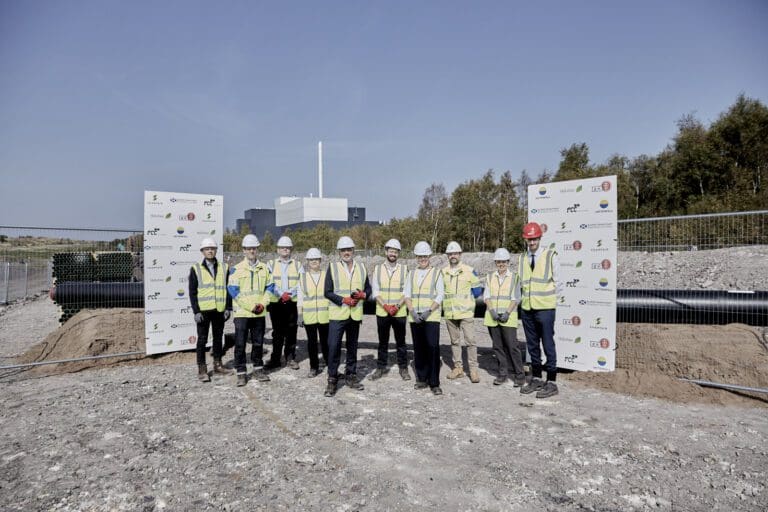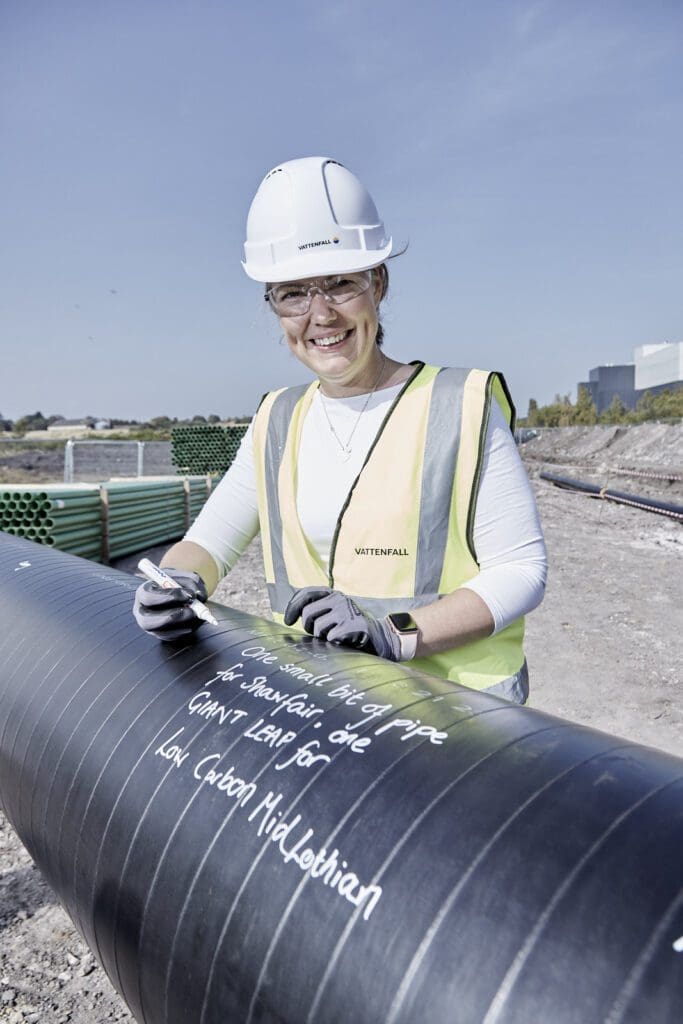
The participating organisations signed ceremonially before installing a district heating pipe section in the trench.
The joint venture’s primary objective is to revitalise and decarbonise Midlothian by delivering low-carbon heat through an underground pipeline network to newly constructed homes in a former coal mining area. The event brought together key stakeholders who play pivotal roles in the area’s future decarbonisation and regeneration.
In its initial phase, the network will supply approximately 3,000 homes, educational facilities, and retail properties in Shawfair Town with heat.

This heat source will be derived from waste heat generated by the Millerhill Recycling and Energy Recovery Centre, an energy-from-waste plant operated by FCC Environment. This initial heat supply will develop a broader regional network extending into south Edinburgh and East Lothian.
Expansion of district heating network
The Shawfair development is a cornerstone of Midlothian Energy Limited’s five-year business plan to provide low-carbon heat to more than 30,000 households and advance other energy projects. As the district heating network expands, heat will be sourced from other waste heat outlets, including heat from local mine workings.
Once vital sources of energy and raw materials, coal mines powered industries in the 19th and 20th centuries and heating homes. After closing these mines and ceasing pumping operations, they filled with water, which naturally heats through geothermal processes.

This heat can be transferred from the mine water to clean water in a district heating network, providing warmth to local residences and businesses. These coalfields are former contributors to climate change, now instrumental in decarbonising the heat supply, supporting Scotland’s low-carbon future.
Midlothian Energy and Vattenfall Heat UK are collaborating with the Coal Authority to explore using heat from a proposed mine water treatment scheme in Dalkeith, one of several pioneering mine water heat projects being considered in Scotland.
Enabling energy storage
The construction of the district heating network commenced earlier this year and presented challenges due to the need to avoid numerous former mine shafts in the area. However, having these shafts nearby may eventually prove advantageous for the district heating infrastructure, potentially enabling energy storage.
Vattenfall Heat UK has enlisted the services of the Scottish company FES Group to implement low-carbon heating in Shawfair Town, a development overseen by Shawfair LLP, located in the northern part of the Midlothian Council area. This project represents Vattenfall’s inaugural heat project in Scotland and is the flagship project for Midlothian Energy Limited. A substantial portion of the 4-kilometre pipeline network has already been installed.
Heat delivery to homes is anticipated by June 2024, with the initial phase of the network expected to reduce CO2 emissions by over 2,500 tonnes per year, equivalent to removing 1,200 cars from the road. The project will benefit from up to £7.3 million from the Scottish Government’s Low Carbon Infrastructure Transformation Project (LCITP).
Jenny Curtis, managing director at Vattenfall Heat UK, said:
“Without the rapid deployment of heat networks at scale, it is simply not possible for Scotland to reach its ambitious net zero by 2045 targets.
“Using waste heat from sources like energy from waste plants and mine workings is a no-brainer. The heat is already there; all we need is the urgent deployment of low-carbon heating infrastructure to capture it and supply it to local residents and businesses.
“We are so excited to build on Midlothian’s proud heritage and make the shift to create a low-carbon, clean energy network for the local community, inspiring the next generation into low-carbon, local jobs.”
Midlothian Council’s cabinet member for environment, councillor Dianne Alexander, said:
“We are delighted to reach this key milestone in our joint venture to deliver low carbon heat projects across the Midlothian Council area.
“Our innovative approach to working with a highly experienced partner will help Midlothian deliver on our ambitious net zero plans and contribute to reducing fuel poverty.”
Nick Waugh, director at Shawfair LLP said:
“Shawfair LLP takes immense pride in the rich mining heritage of our local community and is equally delighted to help facilitate the transition to a low-carbon heat source working with Midlothian Council and Vattenfall, introducing district heating at scale to our new housing. Part of a package of initiatives delivering a sustainable low-carbon environment and future-proofing our new vibrant modern town.”
James Reid, FES energy operations director at FES Group, said:
“The Shawfair Development is the start of a new era for Midlothian. FES Group believes the use of waste heat from the Millerhill Recycling and Energy Recovery Centre (RERC) and low carbon technologies in the MEL Energy Centre will provide the catalyst for future generations to meet the challenge of net zero for Midlothian and the surrounding areas.
“The project demonstrates that business models such as MEL can bring experienced private businesses and local authorities together, providing value to local communities and the inspiration for more low carbon infrastructure schemes throughout Scotland. We are delighted that MEL has chosen FES Group to be the Principal Contractor for this regenerative journey of the area.”
Steve Longdon, chief executive officer for FCC Environment, said:
“Since 2019, the Millerhill Recycling and Energy Recovery Centre (RERC) has been converting non-recyclable household and business waste into heat and power. The plant was developed by us alongside The City of Edinburgh Council and Midlothian Council to help them divert 155,000 tonnes of waste from landfill each year and the facility is a key component in the Councils’ combined commitment to helping to reach the Scottish Government’s Zero Waste target.
“With net zero ever on the agenda and a pressing need to invest in UK-based renewable power sources as we seek to move to a lower carbon future economy, utilising the heat from this plant is vital. It is good to see that real progress is being made towards delivering low-cost, low-carbon heating to 170,000⁴ homes in the Midlothian and Edinburgh region, and we are proud to be a part of this major step forward.”
Peter Wormald, principal heat and by-product manager at the Coal Authority, said:
“The Coal Authority continue to support and facilitate access to mine water heat in the Midlothian area and is encouraged by the progress of the low-carbon district heating network for the Shawfair development. We look forward to continuing our work with Midlothian Energy Ltd and Vattenfall Heat UK to confirm the feasibility of adding mine water heat to the heat network.
“Scotland’s coalfield communities could be at the forefront of sustainable heating and cooling – creating green jobs, green skills and green innovation from the mines beneath, whilst making coalfield communities a key part of Scotland’s low-carbon future.”


